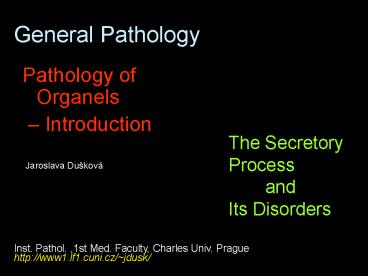General Pathology - PowerPoint PPT Presentation
Title:
General Pathology
Description:
Title: 3 path organels introduction Subject: pathology Author: Ass.Prof. MUDr J. Du kov CSc,FIAC Last modified by: JAROSLAVA dU KOV Created Date – PowerPoint PPT presentation
Number of Views:144
Avg rating:3.0/5.0
Title: General Pathology
1
General Pathology
- Pathology of Organels
- Introduction
The Secretory Process and Its Disorders
Jaroslava Dušková
Inst. Pathol. ,1st Med. Faculty, Charles Univ.
Prague http//www1.lf1.cuni.cz/jdusk/
2
The Cell Components Their Function
- nucleus (incl. nucleolus and nuclear
envelope) - cytoplasm
- cytoplasmic matrix
- cytoplasmic organelles
- plasma membranes
3
The Cell Components Their Function
- The nucleus
- (incl. nucleolus and nuclear envelope)
- chromosomes
- DNA, RNA, histones
4
The Cell Components Their Function
- The nucleus functions
- cell division
- genetic information transcription control
5
Neoplasia (Tumour)
- DNA disease
- Stepwise accumulation
- of genetic abnormalities
- Escape of immunological clearing systems
6
The Cell Components Their Function
The cytoplasm (cytosol) cytoplasmic
matrix cytoplasmic organelles
- ribosomes
- endoplasmic reticulum
- Golgi complex
- lysosomes
- peroxisomes
- mitochondria
- cytoskeleton
- caveolae
- vaults
7
The Cell Components Their Function
The cytoplasm (cytosol) aqueous solution with
enzymes
8
The Cell Components Their Function
- The cytoplasm function
- proteosynthesis (in coop. with organelles)
- storage unit (fat, carbohydrates and
secretory vesicles)
9
The Cell Components Their Function
The cytoplasm - cytoplasmic organelles
- ribosomes
- endoplasmic reticulum
- Golgi complex
- lysosomes
- peroxisomes
- mitochondria
- cytoskeleton
- caveolae
- vaults
10
The Cytoplasmic Organelles Functions (1)
Organelle Composition Function
ribosomes RNA protein complexes proteosynthesis
endoplasmic reticulum cisternae,tubular channels proteosynthesis transport
Golgi complex (GC) smooth membranes vesicles processing and packaging
lysosomes sacklike GC derived digestion
11
The Cytoplasmic Organelles Functions (2)
Organelle Composition Function
peroxisomes lysosomes like producing or using H2O2 detoxication
mitochondria membrane bound energy production Oxydative fosforylation, cell signaling, pH control, Ca homeostasis
12
Mitochondrial DNA somatic mutations (point
mutations and large deletions) and mtDNA variants
in human thyroid pathology A study with emphasis
on Hurthle cell tumors Máximo V et al, Am J
Pathol 1601857, 2002
13
Hürthle cell features Mitochondrial
proliferation Activation of HIF-1
Decreased apoptosis Tumourigenesis
Nuclear genes Ex. GRIM-19
Mt genes (Complex I, III, IV, V)
14
Peroxisomes - microbodiesup to 2 microns -
catalase
- Function
- Degradation substrate oxidation (etanol)
- Anabolism synthesis of prostaglandin ,
cholesterol, billiary acids, plasmalogens,
gluconeogenesis, transamination
15
The Cytoplasmic Organelles Functions (3)
Organelle Composition Function
Cytoskeleton Microtubules actin microfilaments Microvilli, cilia, flagella
Caveolae Membrane indentations Shuttling material
Vaults Octagonal barrrels like ribonucleoproteins Shuttling molecules
16
The Cell Components Their Function
- The plasma membranes
- cell surrounding
- organelles enclosing
- bilayer of lipids and proteins
17
Cell mechanism Membrane function
Structure Compartmentalization, cytoskeleton ER contacts, fluid electrolyte balance
Protection Barrier to toxins foreign organisms/cells
Activation of cell Hormones, mitogens, antigens, growth proliferation factors
Storage Receptors, transport, diffusion, exocytosis, endocytosis
Cell to cell interaction Communication attachment junctional complexes, nutritive relationship, enzymes and antibody release
18
Organelles Involved in Secretion
- membrane type
- maternal origin (ovum cytoplasm)
- autoreplicative
- granular (rough) endoplasmic reticulum
- Golgi apparatus
- lysosomes
19
Exocytosis and Its Disorders
- protein secretion on the granular endoplasmic
reticulum - cis Golgi network
- trans Golgi network (signal molecules
attachment) Golgi Endoplasmic Reticulum
Lysosomes
20
Secretion
- exocrine (apical pole of the cell
lumen, duct) - endocrine (basal pole of the cell
blood) - paracrine influencing neighbouring cells
- autocrine self influencing
21
Secretion
- continual - permanent - unregulated
- pulsatory - regulated
22
Secretion
- continual - permanent
- unregulated vesicle transport
- protocolagen, proteoglycans, viral
particles - Targetting
- immunoglobulins without and after stimulation
23
Secretion
- pulsatory - regulated
- exocrine mucin or zymogen granules
secretion - endocrine cells
- neurons
- T-lymphocytes
- heparinocytes
- thrombocytes
- granulocytes
- endothelia
membrane budding coating proteins
24
Secretion Disorders
- defects of synthesis
- product itself
- auxilliary proteins
- retention in GER
- (inborn endoplasmic reticulum storage
diseases) - hyaline droplets (Russel bodies)
25
Neuroendocrine Secretion
- dense core granules
- secretory vesicles
- (small synaptic vesicles)
26
Neuroendocrine Secretion Disorders
- defects of synthesis
- product itself
- auxilliary proteins
- regulation disorders on the receptor
level
27
Membrane Components of Secretory Granules and
Vesicles
- Synaptophysin (synaptic vesicle protein)
- Neuron Specific Enolase
- S-100 protein
- identification of neuroendocrine
- neoplasms
























![[PDF] Oral Pathology for the Dental Hygienist 8th Edition Kindle PowerPoint PPT Presentation](https://s3.amazonaws.com/images.powershow.com/10084211.th0.jpg?_=20240723102)






